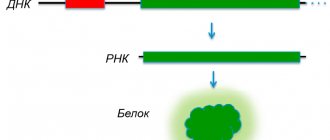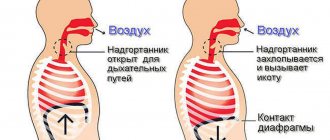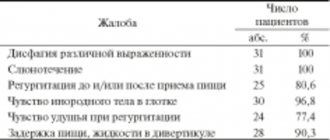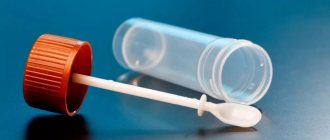Detailed description of the study
The implementation of basic digestive functions in the body is a complex process that is regulated by the work of a number of gastrointestinal peptides.
Gastrointestinal hormones (peptides) are a group of substances that are produced by glandular cells of the mucous membrane lining the gastrointestinal tract. Insufficient or excessive synthesis of gastrointestinal hormones, which occurs due to a number of pathologies of the digestive system, disrupts normal digestive processes.
One of the representatives of this group of hormones is gastrin. It is synthesized by special endocrine G cells of the gastrointestinal tract. Gastrin acts on specific gastrin receptors in the stomach and stimulates the synthesis of hydrochloric acid. Normally, the secretion of hydrochloric acid increases after eating and then decreases. An increase in the concentration of hydrochloric acid reduces the production of gastrin through a feedback mechanism.
Gastrin also affects the formation of gastric juice, bile and mucus. Regulates the digestive process, affecting the motility of the stomach and small intestine. This hormone also affects the motor activity of muscles in the wall of the stomach and small intestine.
Hypergastrinemia (excessive synthesis of gastrin) occurs due to a number of pathologies of the digestive system (gastritis, peptic ulcer), stress, B12-deficiency anemia and malignant tumors of the stomach.
Excessive synthesis of gastrin (hypergastrinemia) occurs due to pathological changes in the digestive system (hyperplasia of G cells that produce this hormone, with B12-deficiency anemia, benign and malignant neuroendocrine formations of the stomach - gastrinomas).
Due to prolonged hypergastrinemia, Zollinger-Ellison syndrome is formed.
Patients complain of:
- Weakness;
- Loss of appetite;
- Severe pain in the solar plexus area;
- Nausea;
- Vomiting;
- Diarrhea.
During instrumental studies, multiple ulcers can be detected in the stomach, duodenum and small intestine. Benign or malignant gastrinoma (a tumor that produces gastrin) is also diagnosed. Gastrinoma is usually located in the duodenum or pancreas.
Most often, a malignant gastrinoma is diagnosed, which has practically not manifested itself in any way before. Malignant gastrinoma, as a rule, actively metastasizes to neighboring organs and tissues.
Diagnosis of gastrinomas presents certain difficulties, because patients, as a rule, use drugs from the proton pump inhibitor group to suppress the symptoms of the disease.
Laboratory diagnosis is based on determining the level of gastrin in the blood serum in combination with determining the basal level of gastric secretion, conducting provocative tests (with intravenous administration of calcium or synthetic secretin). With gastrinoma, severe hypergastrinemia (more than 150 pg/ml) will be observed.
To clarify the nature of the tumor, it is necessary to conduct an immunohistochemical study, and evaluate the functional activity by reaction with antibodies to the corresponding hormones.
An increase in gastrin synthesis is also provoked by the use of certain medications, these include proton pump inhibitors, antacids, glucocorticoids and others.
Determining the level of gastrin in the blood serum is an important diagnostic test to determine the causes of ulcerative lesions of the gastrointestinal tract and if gastrinoma is suspected. Also, based on the results of the study, the specialist determines the tactics of further therapy.
Recommendations
- ^ a b c
GRCh38: Ensemble issue 89: ENSG00000184502 — Ensemble, May 2017 - ^ a b c
GRCm38: Ensembl release 89: ENSMUSG00000017165 - Ensembl, May 2017 - "Human's Guide to PubMed:". National Center for Biotechnology Information, US National Library of Medicine
. - "Mouse PubMed link:". National Center for Biotechnology Information, US National Library of Medicine
. - Lund T, Geurts van Kessel AH, Haun S, Dixon JE (May 1986). “The human gastrin and cholecystokinin genes are located on different chromosomes.” Human Genetics
.
73
(1):77–80. Doi:10.1007/BF00292669. PMID 3011648. S2CID 32216320. - Blanco, Antonio; Blanco, Gustavo (2017), "Biochemical basis of endocrinology (II), hormones and other chemical intermediates", Medical Biochemistry
, Elsevier, pp. 573–644, doi:10.1016/b978-0-12-803550-4.00026-4, ISBN 9780128035504 - Feng J, Petersen SD, Coy DH, Jiang JC, Thomas SJ, Pollack MR, Wank SA. (October 2010). “The calcium-sensing receptor is a physiological multimodal chemosensor that regulates gastric G-cell growth and gastrin secretion.” Proceedings of the National Academy of Sciences of the United States of America
.
107
(41):17791–6. doi:10.1073/pnas.1009078107. PMC 2955134. PMID 20876097. - Holst J. J., Orskov S., Seier-Poulsen S. (1992). "Somatostatin is an important paracrine player in the acid inhibition of gastrin secretion." Digestion
.
51
(2):95–102. Doi:10.1159/000200882. PMID 1354190. - Johnson, L. R. (March 1984). "Effect of somatostatin and acid on the inhibition of gastrin release in neonatal rats". Endocrinology
.
114
(3):743–6. Doi:10.1210/endo-114-3-743. PMID 6141932. Archived from the original on 2008-09-05. Retrieved 2011-05-17. - Lindström, E.; Chen, D.; Norlén, P.; Andersson, K.; Hokanson, R. (2001). "Control of gastric acid secretion: the gastrin-ECL-cell-parietal cell axis". Comparative biochemistry and physiology.
Part A, Molecular and Integrative Physiology .
128
(3):505–514. Doi:10.1016/s1095-6433 (00) 00331-7. ISSN 1095-6433. PMID 11246041. - Tortora, G. J., & Grabowski, S. R. (1996). Fundamentals of anatomy and physiology. New York, NY: HarperCollins College. 14th ed. Pg 906
- Vadokas B, Lüdtke FE, Lepsien G, Golenhofen K, Mandrek K (December 1997). "Effect of gastrin-releasing peptide (GRP) on mechanical activity of the human ileocecal region in vitro." Neurogastroenterology and motility
.
9
(4): 265–70. Doi:10.1046/j.1365-2982.1997.d01-59.x. PMID 9430795. S2CID 31858033. - Valenzuela J. E., Walsh J. H., Isenberg J. I. (September 1976). "The influence of gastrin on the secretion of pancreatic enzymes and gallbladder emptying in humans." Gastroenterology
.
71
(3):409–11. Doi:10.1016/S0016-5085 (76) 80445-3. PMID 950091. - Castell D.O. (February 1978). "Gastrin and the tone of the lower esophageal sphincter." Archives of Internal Medicine
.
138
(2): 196. doi:10.1001/archinte.138.2.196. PMID 626547. - Henderson J.M., Lidgard J., Osborne D.H., Carter D.C., RC Title (February 1978). “The response of the lower esophageal sphincter to gastrin—pharmacological or physiological?” Intestines
.
19
(2): 99–102. Doi:10.1136 / gut.19.2.99. PMC 1411818. PMID 631634. - Indu Khurana (2006). Textbook of Medical Physiology
. New Delhi: Reed Elsevier India. item 605. ISBN 978-8181478504. OCLC 968478170. - Baron, J. H. (1978). Clinical tests of gastric secretion
. Doi:10.1007/978-1-349-03188-7. ISBN 978-1-349-03190-0. - Schiffmann R., Dwyer N.K., Lubensky I.A., Tsokos M., Sutliff V.E., Latimer J.S., Frey K.P., Brady R.O., Barton N.V., Blanchett-Mackie EJ, Goldin E (February 1998). "Constitutive achlorhydria in mucolipidosis type IV." Proceedings of the National Academy of Sciences of the United States of America
.
95
(3):1207–12. doi:10.1073/psas.95.3.1207. PMC 18720. PMID 9448310. - "Review Article: Strategies for Determining Whether Hypergastrinemia Is Zollinger-Ellison Syndrome rather than a More Common Benign Cause." www.medscape.com
. - Adkins JS (March 1906). "Chemical mechanism of gastric secretion". Journal of Physiology
.
34
(1–2): 133–44.
doi:10.1113/jphysiol.1906.sp001146. PMC 1465807. PMID 16992839. [ permanent dead link
] - Modlin I.M., Kidd M., Marks I.N., Tan L.H. (February 1997). "The Key Role of John S. Adkins in the Discovery of Gastrin". World Journal of Surgery
.
21
(2): 226–34. Doi:10.1007/s002689900221. PMID 8995084. S2CID 28243696. - Gregory RA, Tracy HJ (1964). "Composition and properties of two gastrins extracted from porcine antral mucosa: Part I, isolation of two gastrins from porcine antral mucosa." Intestines
.
5
(2): 103–107. Doi:10.1136/gut.5.2.103. PMC 1552180. PMID 14159395. - Gregory H., Hardy P.M., Jones D.S., Kenner G.W., Sheppard R.S. (December 1964). “Antral hormone gastrin. Structure of gastrin". Nature
.
204
(4962):931–3. Doi:10.1038/204931a0. PMID 14248711. S2CID 4262131.
References
- Clinical recommendations. Neuroendocrine tumors., approved. Ministry of Health of the Russian Federation, 2022.
- Stepanov, Yu.M. Serum gastrin content in patients with reflux gastritis. // Stepanov Yu.M., Mosiichuk L.N., Kovalenko A.N. – Gastroenterology, 2014 No. 2(52). — P. 52-56.
- Tereshchenko, I.V. On the issue of diagnosing gastrinoma. – Povolzhsky Oncological Bulletin, 2022. No. 3(40). — P. 56-60.
- Schubert, M., Rehfeld, J. Gastric peptides-gastrin and somatostatin. – Comprehensive Physiology, 2022. – Vol. 18;10(1). — P.197-228. doi: 10.1002/cphy.c180035.
further reading
- Rosengurth E, Walsh JH (2001). "Gastrin, CCK, signaling and cancer". Annual Review of Physiology
.
63
: 49–76. Doi:10.1146/annurev.physiol.63.1.49. PMID 11181948. - Dockray GJ (December 2004). “Clinical endocrinology and metabolism. Gastrin." Best practices and research.
Clinical endocrinology and metabolism .
18
(4): 555–68. doi:10.1016/j.beem.2004.07.003. PMID 15533775. - Anlauf M, Garbrecht N, Henopp T, Schmitt A, Schlenger R, Raffel A, Krausch M, Gimm O, Eisenberger CF, Knoefel WT, Dralle H, Komminoth P, Heitz PU, Perren A, Klöppel G (September 2006) . "Sporadic and hereditary gastrinomas of the duodenum and pancreas: selected clinicopathological and epidemiological features." World Journal of Gastroenterology
.
12
(34): 5440–6. doi:10.3748/wjg.v12.i34.5440. PMC 4088224. PMID 17006979. - Polosatov M.V., Klimov P.K., Masevich V.G., Samartsev M.A., Wunsch E. (April 1979). "Interaction of synthetic large human gastrin with blood proteins in humans and animals." Acta Hepato-Gastroenterologica
.
26
(2): 154–9. PMID 463490. - Fritsch WP, Hausamen TU, Scholten T (April 1977). “[Gastrointestinal hormones. I. Hormones of the gastrin group]. Zeitschrift für Gastroenterologie
.
15
(4): 264–76. PMID 871064. - Higashimoto Y., Himeno S., Shinomura Y., Nagao K., Tamura T., Tarui S. (May 1989). "Purification and structure determination of urinary NH2-terminal large gastrin fragments". Reports of biochemical and biophysical research
.
160
(3):1364–70. Doi:10.1016/S0006-291X (89) 80154-8. PMID 2730647. - Pauwels, S., Najdowski, T., Dimaline, R., Lee, S. M., Deschodt-Lankman, M. (June 1989). "Degradation of human gastrin and CCK by endopeptidase 24.11: different behavior of sulfated and non-sulfated peptides". Biochimica et Biophysica Acta (BBA) - Protein structure and molecular enzymology
.
996
(1–2):82–8. Doi:10.1016/0167-4838(89)90098-8. PMID 2736261. - Lund T, Geurts van Kessel AH, Haun S, Dixon JE (May 1986). “The human gastrin and cholecystokinin genes are located on different chromosomes.” Human Genetics
.
73
(1):77–80. Doi:10.1007/BF00292669. PMID 3011648. S2CID 32216320. - Kariya, Y., Kato, K., Hayashizaki, Y., Himeno, S., Tarui, S., Matsubara, K. (1986). "Expression of the human gastrin gene in normal and gastrinoma tissues". Gen.
_
50
(1–3): 345–52. Doi:10.1016/0378-1119(86)90338-0. PMID 3034736. - Gregory R.A., Tracy H.J., Agarwal K.L., Grossman M.I. (August 1969). "Amino acid composition of two gastrins isolated from Zollinger-Ellison tumor tissue". Intestines
.
10
(8): 603–8. Doi:10.1136 / gut.10.8.603. PMC 1552899. PMID 5822140. - Bentley PH, Kenner GW, Sheppard RC (February 1966). "Structures of human gastrins I and II". Nature
.
209
(5023):583–5. Doi:10.1038/209583b0. PMID 5921183. S2CID 4200721. - Ito, R., Sato, K., Helmer, T., Jay, J., Agarwal, K. (August 1984). "Structural analysis of the gene encoding human gastrin: the large intron contains an Alu sequence." Proceedings of the National Academy of Sciences of the United States of America
.
81
(15):4662–6. doi:10.1073/psas.81.15.4662. PMC 391550. PMID 6087340. - Wiborg O, Berglund L, Boel E, Norris F, Norris K, Rehfeld JF, Marker KA, Vuust J (February 1984). "Structure of the human gastrin gene." Proceedings of the National Academy of Sciences of the United States of America
.
81
(4):1067–9. doi:10.1073/pnas.81.4.1067. PMC 344765. PMID 6322186. - Kato K, Hayashizaki Y, Takahashi Y, Himeno S, Matsubara K (December 1983). "Molecular cloning of the human gastrin gene." Nucleic acid research
.
11
(23):8197–203. Doi:10.1093/nar/11.23.8197. PMC 326575. PMID 6324077. - Boel, E., Wuust, J., Norris, F., Norris, C., Wind, A., Rehfeld, J. F., Marker, K. A. (May 1983). "Molecular cloning of human gastrin cDNA: evidence for the evolution of gastrin by gene duplication." Proceedings of the National Academy of Sciences of the United States of America
.
80
(10):2866–9. doi:10.1073/pnas.80.10.2866. PMC 393933. PMID 6574456. - Kato K, Himeno S, Takahashi Y, Wakabayashi T, Tarui S, Matsubara K (December 1983). "Molecular cloning of the human gastrin precursor cDNA". Gen.
_
26
(1):53–7. Doi:10.1016/0378-1119(83)90035-5. PMID 6689486. - Ko TJ, Wang TC (November 1995). "Molecular cloning and sequencing of the mouse gastrin gene". Reports of biochemical and biophysical research
.
216
(1):34–41. doi:10.1006/bbrc.1995.2588. PMID 7488110. - Rehfeld, J. F., Hansen, S. P., Johnsen, A. H. (January 1995). "Post-poly(Glu) cleavage and degradation modified by O-sulfated tyrosine: a novel post-translational processing mechanism". EMBO Magazine
.
14
(2): 389–96. Doi:10.1002/j.1460-2075.1995.tb07013.x. PMC 398093. PMID 7530658. - Rehfeld, J. F., Johnsen, A. H. (August 1994). “Identification of gastrin component I as gastrin-71. The highest possible bioactive progastrin product." European Journal of Biochemistry
.
223
(3):765–73. Doi:10.1111/j.1432-1033.1994.tb19051.x. PMID 8055952. - Varro A, Dockray JJ (November 1993). "Post-translational processing of progastrin: inhibition of cleavage, phosphorylation and sulfation by brefeldin A". Biochemical Journal
.
295
(Pri 3): 813–9. doi:10.1042/bj2950813. PMC 1134634. PMID 8240296.







